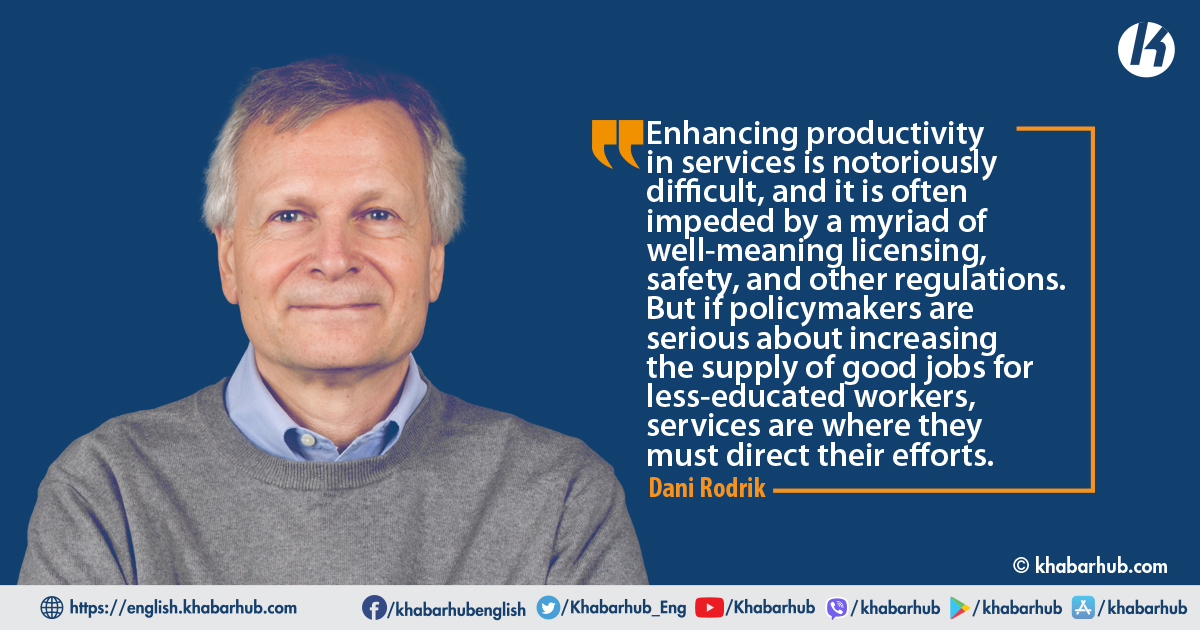Good jobs have become a top priority worldwide. Policymakers in advanced and developing economies alike are stressing the need for well-paying employment opportunities with job security and career ladders.
Globalization and technological change have made it painfully clear that this task cannot be left wholly to markets.
When policymakers talk about creating good jobs, they typically focus on things like minimum wages, collective bargaining, and investments in skills.
But as important as such interventions are, they are not enough. Productivity is key. The supply of good jobs can increase only if the jobs that are created for the bottom and middle of the skill distribution become more productive, enabling higher pay, more autonomy, and brighter career prospects for those who hold them.
Otherwise, mandating higher wages and better workplace conditions can leave less-educated workers priced out of employment opportunities. France, with its very high rate of youth unemployment, presents a cautionary tale.
Another problem, however, is that even when policymakers do talk about industrial and innovation policies that specifically target increased productivity and new technologies, good jobs are treated as a side issue.
Care workers who have greater autonomy and decision-making authority can use their knowledge of residents and patients to customize their services and provide more flexibility (such as in schedules, food, and treatment).
In the United States, the latest crop of such policies targets advanced manufacturing such as semiconductors (through the CHIPS Act) and green technologies (through the Inflation Reduction Act); and in Europe, the focus is on “digitalization” alongside the green transition. In both settings, it is simply assumed that good jobs will emerge as a byproduct of these programs, even though that is not their primary purpose.
In fact, green technologies and advanced manufacturing are unlikely to be a major source of net job creation for the kinds of workers who are ill-served by today’s labor markets.
After all, manufacturing employs fewer than one in ten workers in the US, and the experience of other countries where manufacturing has done much better (such as Germany, South Korea, and Taiwan) suggests that reversing the de-industrialization of employment is extremely difficult – indeed, unprecedented.
Since the bulk of future jobs will come from services, that is where we must focus our efforts to create productive jobs for less advantaged workers. In a new study for the Hamilton Project, I describe what an industrial policy for services might look like for the US.
My proposal has both a local and a national component. The local component builds on existing development and business assistance programs that take the form of collaborative partnerships between development agencies, firms, and other stakeholders aiming to revitalize communities and create good jobs.
The national initiative features an Advanced Research Projects Agency (ARPA) focused on the promotion of a particular type of innovation: employment-friendlyConsider what is perhaps the toughest test case for these ideas: long-term care.
This is a sector where employment will increase rapidly as the population continues to age, and as demand for in-home or assisted-living arrangements increases.
But because most long-term care work is done in homes (through agencies that provide caregivers or through self-employed caregivers) or in weakly regulated assisted-living or retirement communities, remuneration and working conditions have traditionally been poor – characteristics that epitomize bad jobs.
Employees are mostly women – and disproportionately women of color – and because their work is typically regarded as low-skill, they are not viewed as real professionals.
How might jobs in long-term care by improved? MIT economist Paul Osterman suggests three overall strategies. First, the government can impose standards, such as higher minimum wages.
Second, policymakers can increase the Medicaid and Medicare reimbursement rates for care services, in the hope that this will lead to a boost in wages.
And third, direct-care workers’ productivity can be raised, which would help the long-term care system better serve patients’ needs and reduce costs, generating room for better compensation.
While the first two strategies might be useful, productivity enhancements ultimately are the most reliable source of better jobs.
To that end, Osterman suggests an approach that is analogous to Japanese automakers’ pioneering method of deploying new innovations in manufacturing.
But if we cannot find ways to increase productivity in the occupations for which our workers are destined, we will end up with an even worse-performing, less inclusive “bad-jobs” economy.
This entails a combination of investing in workers’ skills; providing workers with greater voice, discretion, and autonomy; and giving them more responsibility for the quality of the service.
Care workers who have greater autonomy and decision-making authority can use their knowledge of residents and patients to customize their services and provide more flexibility (such as in schedules, food, and treatment).
Importantly, this strategy would also permit the introduction of new technologies that complement caregivers’ skills – such as digital tools with which caregivers can collect real-time information and respond faster and more efficiently to residents’ needs.
These changes would require a willingness to experiment with novel work practices and a continuum of efforts, moving from research and development and the introduction of new technologies for long-term care to their local adoption, adaptation, and contextualization in specific communities.
If long-term care is managed better in such ways, productivity benefits would show up in lower turnover among care workers, reduced hospitalization rates, better management of chronic conditions, and quicker and smoother transitions out of acute-care facilities.
None of this will be easy. Enhancing productivity in services is notoriously difficult, and it is often impeded by myriad well-meaning licensing, safety, and other regulations.
But if we cannot find ways to increase productivity in the occupations for which our workers are destined, we will end up with an even worse-performing, less inclusive “bad-jobs” economy.
(Dani Rodrik is a Professor of International Political Economy at Harvard University’s John F. Kennedy School of Government)
Copyright: Project Syndicate









Comment